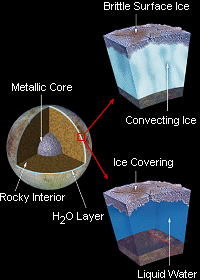What's going on below Europa's surface?
Is there life on Europa? That is the billion dollar question to NASA!
It depends on what's below the icy surface. There are several
theories about the composition and structure of Europa.
Tidal interaction causes internal heating inside Europa. This is only enough to possibly melt out the ice in the interior. But once fluid, it would rise to the surface over the denser rocky and metallic core. The surface is exposed to the bitter cold of space, 128 Kelvin (145 C or -200 F).
The two competing models suggest either a warm, convecting ice (slush) layer, located several kilometers below a cold, brittle surface ice crust (top model), or an underlying layer of liquid water with a possible depth of more than 100 kilometers (bottom model). If a 100 kilometer (60 mile) deep ocean existed below a 15 kilometer (10 mile) thick Europan ice crust, it would be 10 times deeper than any ocean on Earth and would contain twice as much water as Earth's oceans and rivers combined.
Magnesium sulfate (Epsom salt!) might be a major component of Europa's water or ice, as its been seen in spectroscopic measurements of Europa. Recall Earth's oceans are salty due to NaCl. This salt has the very important effect of keeping the water in a liquid state, even if the temperature is below the standard freezing point.
 An Ice Greenhouse
An Ice Greenhouse
The heating of the Europa sub-ocean depends on how much
tidal and radioactive heating is currently occurring on Europa
and how the energy is dissipated:
both a bit hard to quantify exactly. This is why the competing
models above. But there is another source of heating which may
be significant: Solar Energy! Ice acts just a like a greenhouse,
allowing optical Solar light in, but blocking (opaque) thermal
heat radiation from getting out. Such heating might be significant
enough to favor the liquid water model above.
Is there any evidence of liquid water?
YES. The Galileo satellite found that Europa has a weak magnetic field (perhaps 1/4
of the strength of Ganymede's). And most interestingly, it varies
periodically as it passes thru Jupiter's massive magnetic field. This is very
strong evidence that there is a conducting material beneath Europa's
surface, most likely a salty ocean.
